Want better photos of your miniatures? Get a photo light box! You don’t need a fancy camera. Your smart phone will probably do a great job. All you need is “good light”. A light box or photo booth are an important tool if you’re looking for professional quality images of your miniatures.
In this article, I highlight some key information that will improve your photography of gaming models. I also review 5 of the best photo light boxes for photographing miniatures.
If you’re painting the 28-35mm Warhammer 40k scale miniatures, or the larger models, e.g., vehicles or 75mm scale busts, a light box will help give your photos the professional look.
It’s all about light! A photo booth helps you control light.
Here are the 5 Recommended Best Light Boxes for Photographing Miniatures and Models:
In a Hurry? Here’s Our Top Pick! 🏆
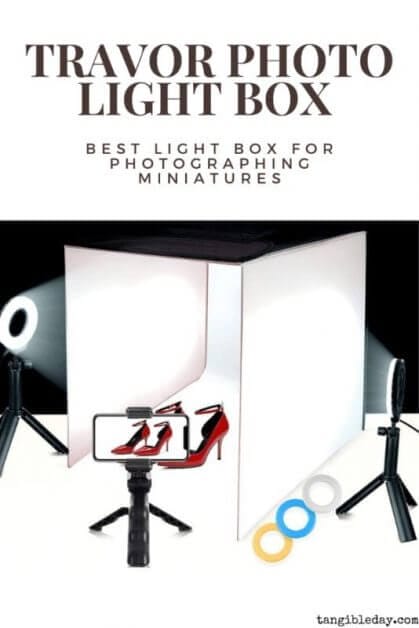
“Portable, versatile, and feature-rich” The Travor light box has everything you need to get started to take professional quality photographs of your tabletop miniatures. It comes with a diffuser box, bright LED lights, and a smartphone tripod.
This photo booth kit is great for hobbyists and product photographers looking to sell their wares on eBay or other online marketplaces. Check out the full review below!
How to Take Better Photos of Miniatures?
Scale modelers and miniature hobbyists put a lot of work into their projects. You’ve invested hours and hours of labor. Why not share your final product? Sharing is part of the fun, too!
Social media is all about visual presence.
It’s the photographic media in today’s world. A great photo grabs your audience’s’ attention. A nicely shot photograph of your painted miniature may also land you a commission project, if that is your goal. Or, you’re just simply looking to become a better artist and photography is part of the hobby.
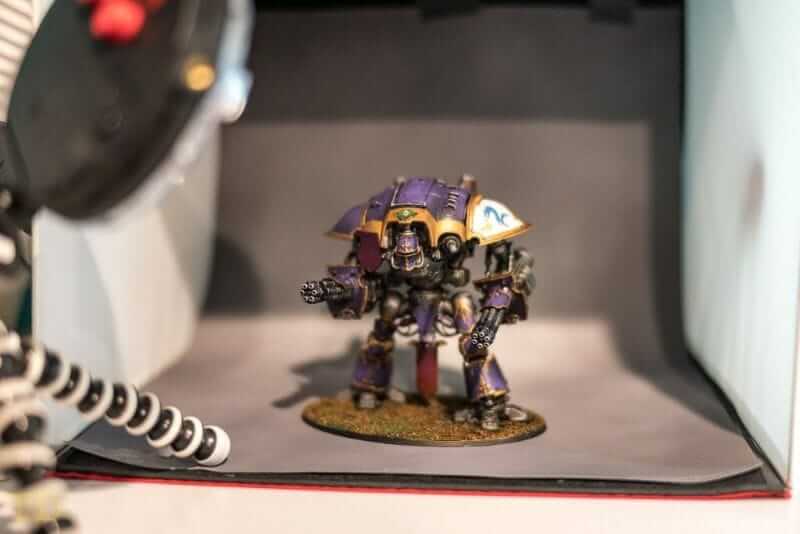
There are 3 main things you need for a great photograph:
- Context
- Light
- Composition
1. Context
Where is your miniature or model located? What is the atmosphere? This doesn’t mean you need to have a fancy backdrop or background of an exotic landscape. Context means showing where your model may exist.
For the miniature artist, this could merely be an open space where your viewer’s imagination fills in the blank. Most product photography is shot without a real background. Instead, a blank color backdrop is used as the context for the subject.
For my work, I’ve settled in with the black backdrop. Actually, in my opinion, the best color backdrop for photographing gaming miniatures is either all white or black.
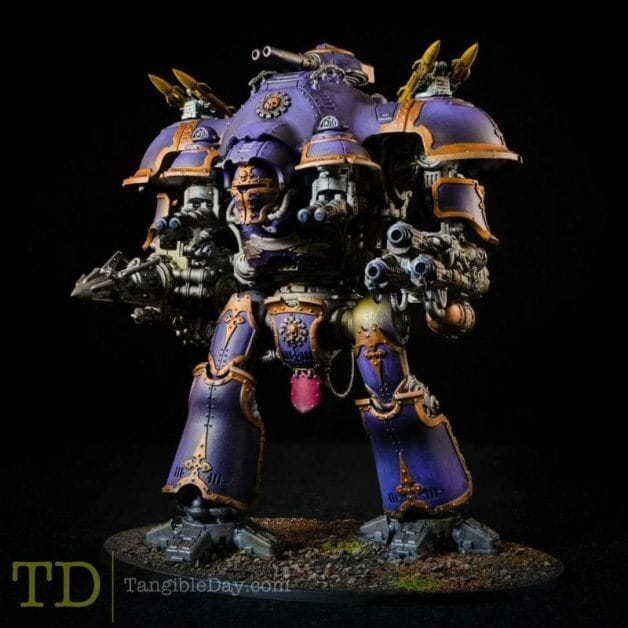
White or black backdrops are the best colors if you’re looking to focus your viewer’s attention on your model. These backdrops aren’t distracting, make it easy to correct for color casts (source), and are simple to use.

Black backgrounds are versatile. The color evokes the concepts of “danger”, “mystery”, and “fantasy”, according to sales marketers. Use these ideas to your advantage.
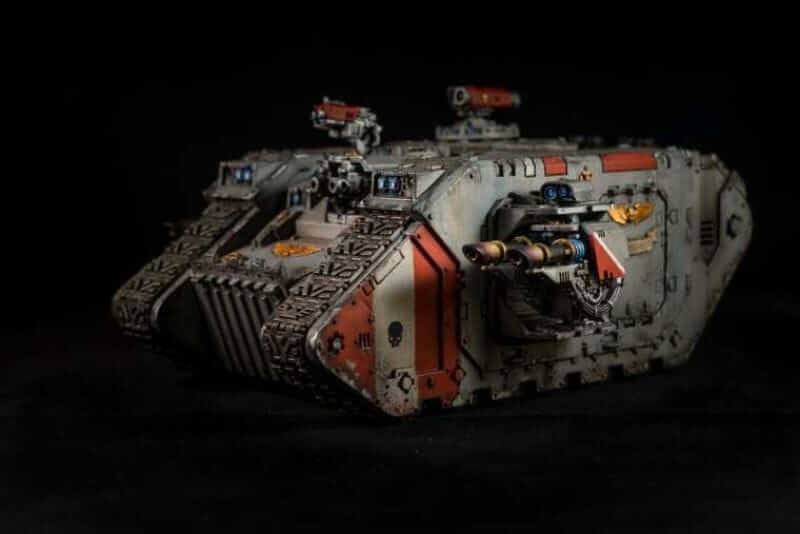
White backgrounds on the other hand is more strongly associated with “purity”, “professional”, and “clean”. Most product photography on websites selling jewelry or other luxury goods use pure white backdrops.

Gradient or textured backdrops are also popular, but it is a lot harder to photograph miniatures with a background that changes tone or value. Keeping your photography system simple goes a long way to improving your workflow.
2. Light
Everything in photography is about light. The word “photography” means “drawing with light” in ancient Greek (source). When you’re photographing miniatures, it is important that the light hitting the model is bright and diffuse.
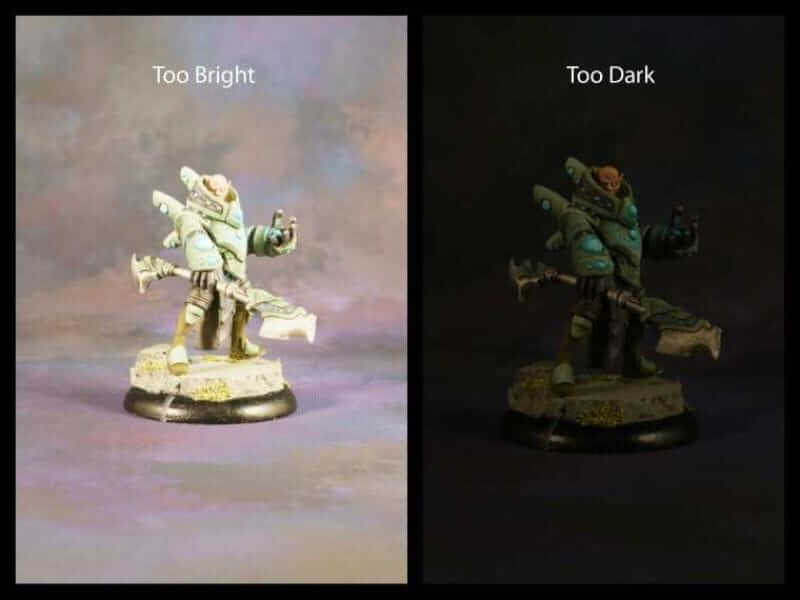
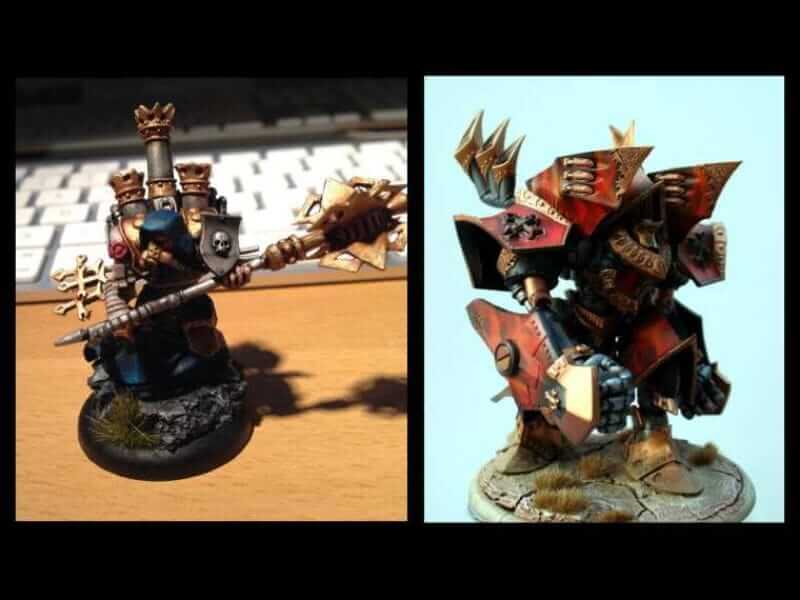
Diffuse light is light that is evenly cast across the subject. Of the two ways to light a model, getting bright enough light is easier than diffusing the light.
The only way to diffuse and evenly light a model is lighting the model directly in the direction the camera lens is pointing. In fact, this is what most photographers naturally try and do.
But, this also means that you might shine too much light (such as with a flash). This creates ugly shadows behind the model and backdrop, or washes out the details on certain model features, e.g., the brighter skin tones.

The easiest way to diffuse light is to 1) bounce the light off another surface or 2) allow it to travel through a translucent material.
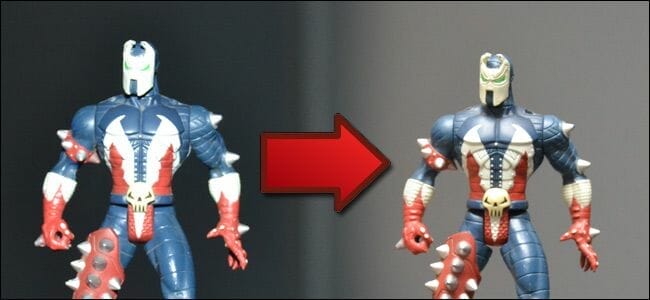
For the most part, in a DIY photographic setup, bouncing your light source is easy. All you have to do is setup your light facing away from your model, and put a semi-reflective surface to allow that light to come back toward the model. For more information about diffusers and using a light tent, check this site out.
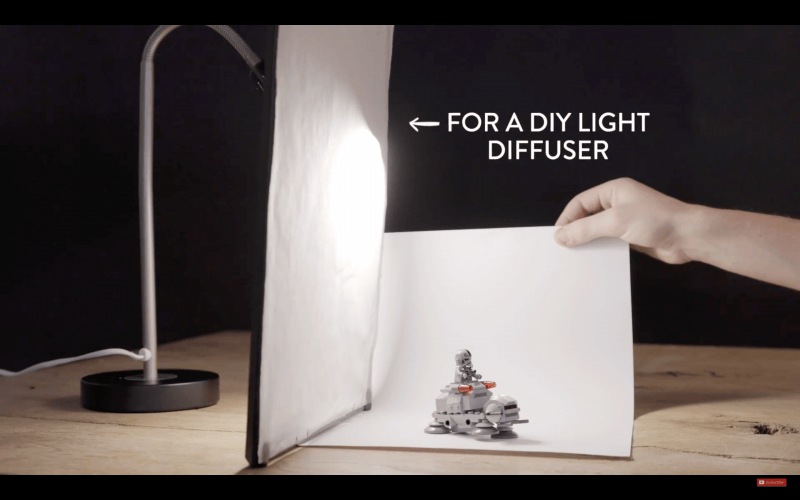
3. Composition
I wrote an article on the importance of composition in photographing miniatures (Related: how to improve your miniature photos using composition).
In 1797, John Thomas Smith, the famous British painter, wrote down the compositional guidelines for “the rule-of-thirds” (also see this modern guide). The basic idea of the rule-of-thirds is to keep the image dynamic; that is, give the viewer empty space to look around. Let the eyes wander.
A subject needs to breath. The image needs to feel like the model can move around in the space within the frame. This kind of compositional setup can vastly improve the interest and aesthetic of your miniature.
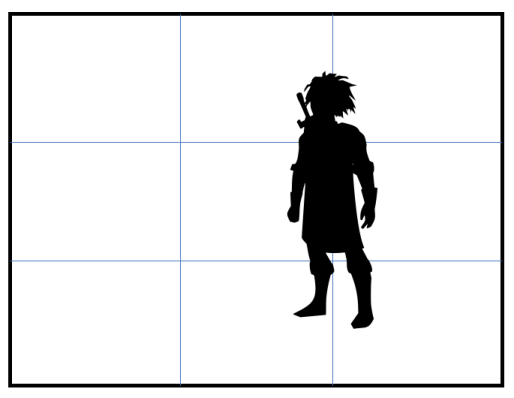
The natural inclination for many new photographers is to center the subject. This is likely because most cameras (or smartphones) have an autofocus setup for the middle parts of the frame.
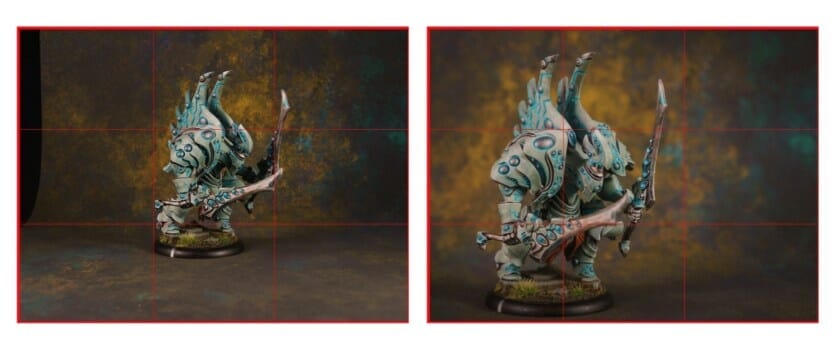
There are other rules of composition, such as how much you should fill your frame with your subject. The golden “angle” for how to place your model, etc. Games Workshop has a great tutorial page on this as well.
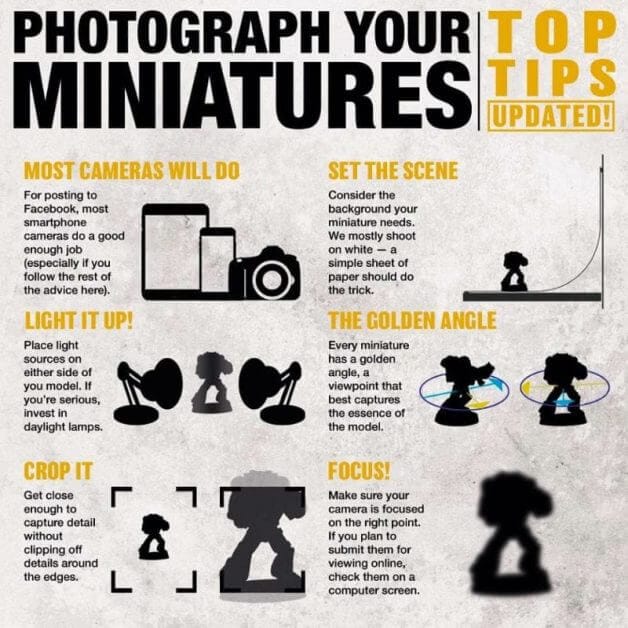
In general, for improving composition, try and place your model in a location within the image frame that gives it dynamism or a tension. For more about how composition and using an eye for “structure” can improve your photograph, see my article on the subject of photographic structure.
As with any art, photography requires patience, practice, and experimentation. But, with time, it’s a skill that you can apply to many aspects of the miniature and modeling hobby.
What Kind of Camera Do I Need for Photographing Miniatures?
Any modern digital camera can take great photos of miniatures. For most, a smart phone would suffice. If you’re looking to up your photographic game, however, a dedicated camera will give you a lot more control over your images.
RELATED: SMARTPHONE VS CAMERA MINIATURE PHOTOGRAPHY: WHAT IS BETTER?
For one thing, a dedicated camera will have a larger sensor (or light sensitive surface). This ensures that you’re able to gather a lot of that light information coming off your miniature. Great photography is about great light.
The best cameras for photographing anything are those cameras that can collect and capture that great light. If you’re the market for a camera specifically for photographing miniatures, I would strongly recommend a mirrorless camera, like a Sony or Fuji system.
These cameras are a major step up from the “point and shoots”, and certainly provide photos that best or rival any smartphone camera technology.
Ultimately, the best camera you use for photographing miniatures is the one you have with you. In other words, just use what you have already and make lots of images.
Do You Need a Photo Light Box?
No. But, it helps! A lot!
Photo light boxes merely help you control how the light hits your model. The advantage of a photo light box is the ability to simply get to work. You can try the do-it-yourself (DIY) route like I did when I first started. Just remember that you’ll have to make the light not only bright enough, but diffuse enough to light up your model properly.
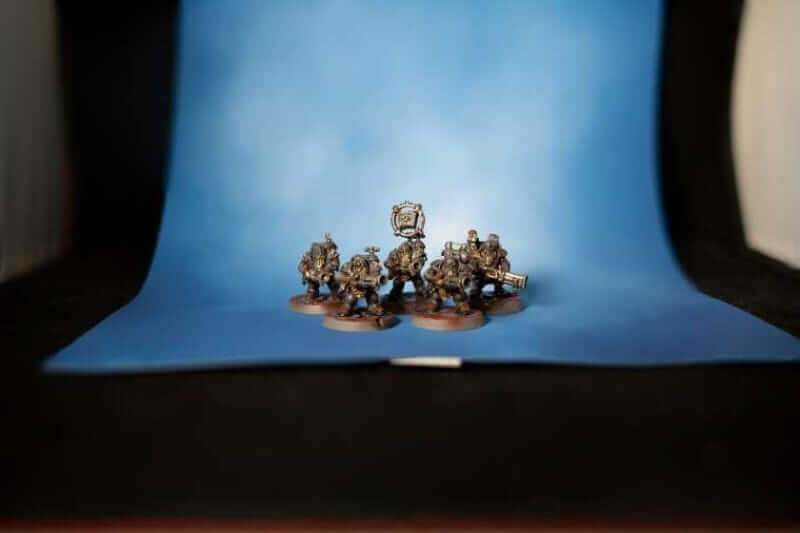
I learned that for a little bit of money (a lot less than I spend on the other parts of the miniature hobby), I have the convenience of a photo studio system that just works well.
The best part is that if you choose the right light box or light tent, it doesn’t take up a lot of space. In fact, the ones I recommend here are all portable!
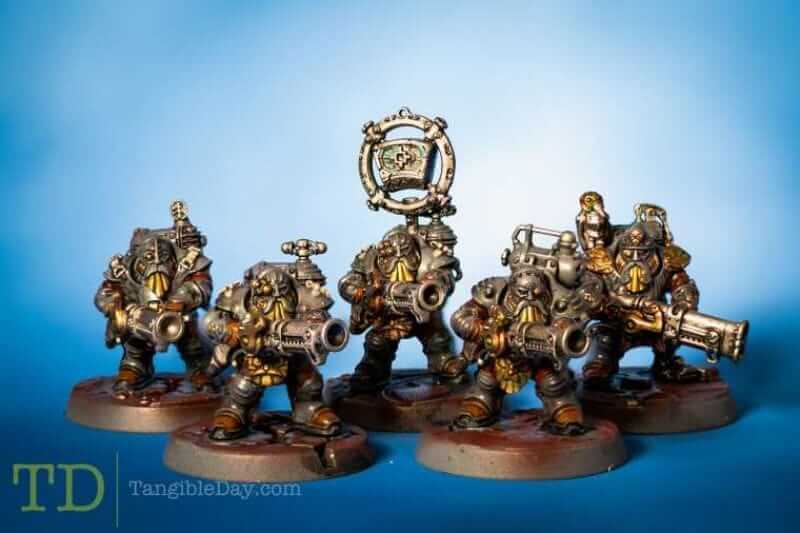
What is the Best Photo Light Box?
The questions you should ask in shopping for photo light box are:
- Is there a sturdy frame to house the backdrop and diffusers?
- Does the lightbox have an included light source?
- Does the product have a tripod for holding my camera still?
- Will my models and miniatures fit inside the photo booth?
- How much footprint space does the light box take up?
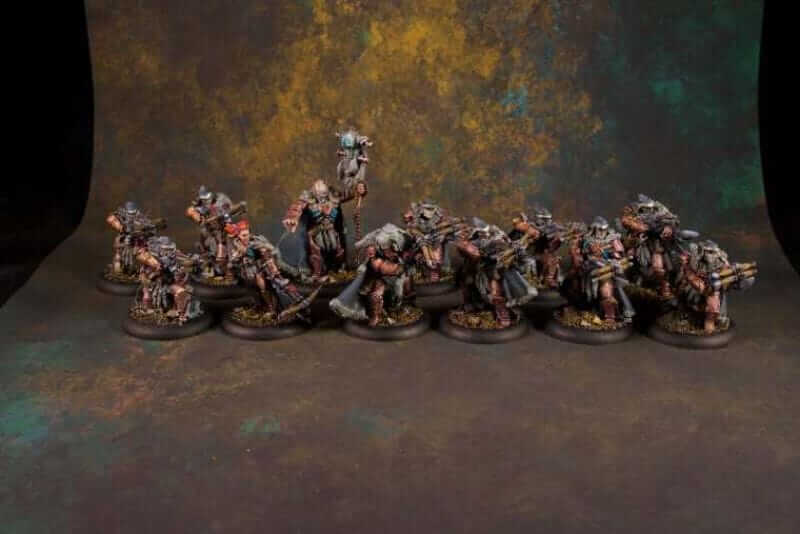
You’ll find that all the light boxes I recommend below have features that allow you to get started right away.
The light box I use for all of my work is the LimoStudio Table Top Photo Photography Studio.
You’ll see why I chose this light box below. But, you’ll also find out that if I had done it all over again, I might have chosen a different photo booth.
Recommended 5 Best Photo Light Boxes for Miniatures and Models
1. Emart Photography Table Top Light Box

The Emart Photography Table Top Light Box is the cheapest of the light boxes on this list. But, it has all the features of the other light booths.
It comes with a small tabletop tripod that will hold any model smartphone. This is great for those of you who plan to photograph models or even turntable video with your phones.
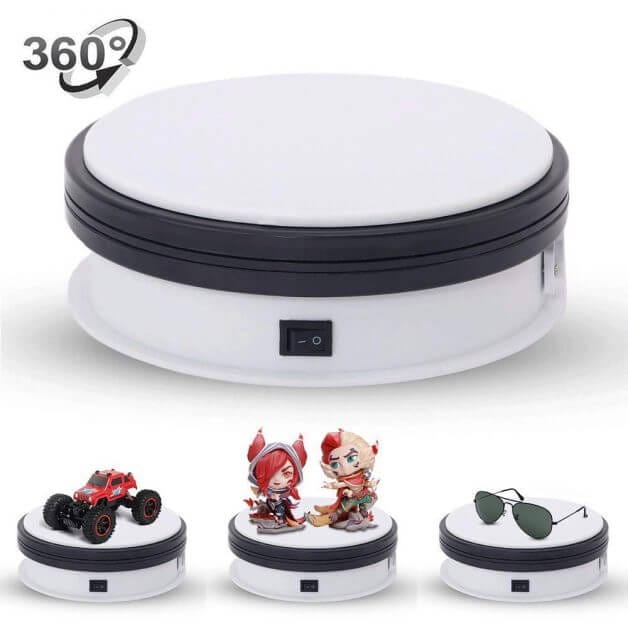
The Emart Photography Table Top Light Box also comes with LED lights that shine fairly bright at 10 watts with a neutral daylight color temperature (5500k) (check here for more info about hobby desk lights).
LED lights are great for photography because they naturally give off more diffuse illumination.
A potential disadvantage of this light box is that it has a relatively small sized internal space (14″x16″). This will fit most models. However, it might be too small for larger vehicles or multiple troop units.
This, of course, is outweighed by the portable feature of this system. The entire photo booth folds down into a lightweight, suitcase sized system. This makes this the best light box for you if you’re looking for the most portable system.
2. Travor Photo Light Box Portable
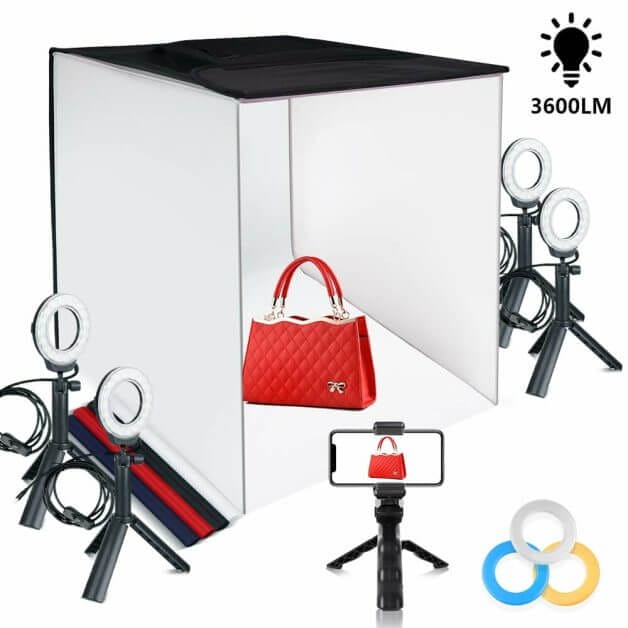
The Travor Photo Light Box Portable is probably the best overall light box. If I had to choose my light box purchase all over again, it would be the Travor light box.
This photo light box provides access to the flexibility to photograph larger models.
Although it is a little more money, it is still very affordable.
The 4 tabletop LEDS are much more powerful and versatile than the Emart photo booth. The color temperature of the lights are also perfect for miniature photography: neutral.
Side note: the LEDs have filter attachments to adjust the color cast of the light, which is a neat feature. I wouldn’t need it for photographing my minis, but maybe if you’re creative, they could come in handy.
It is much hard to properly light up a larger model. This photo booth gives you the tools and space (24″x 24″) to photograph some of the larger models (e.g., 40k Imperial Knights) with ease.
The included multi-colored backdrops gives you some options for changing the background.
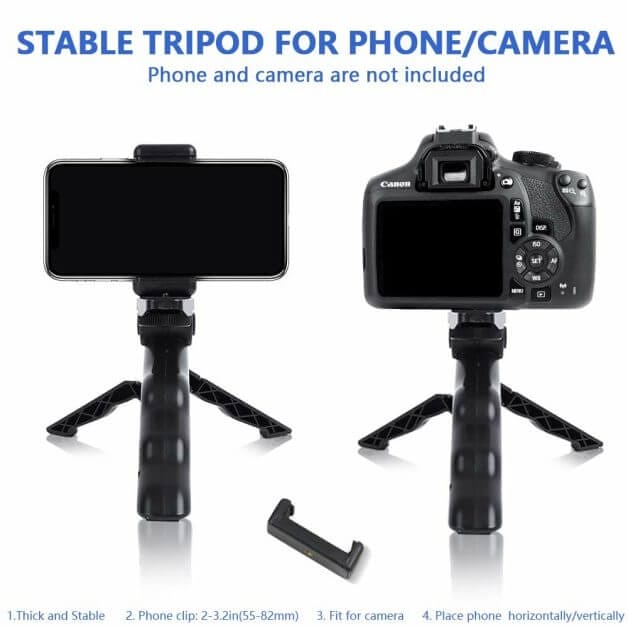
I was pleasantly surprised to find that the Travor light box also comes with a tabletop tripod that can hold a smartphone or a camera. Although, depending on where you set this up, you may want to use a more stable tripod. Most tabletop tripods are sensitive to small movement.
Finally, the Travor photo light box can collapse into a portable package. It’s not quite small, but the light box is lightweight and you carry it wherever you need to go without much trouble.
If I had to choose my light box purchase all over again, it would be the Travor light box.
The larger size is really helpful for photographing multiple or larger models.
3. LimoStudio Table Top Photo Photography Studio

The LimoStudio Table Top Photo Photography Studio is the tabletop photography studio that I have used for years.
As you can see in the picture this photo light booth has everything you need to get started photographing your miniatures.
The light box interior space is 16″x16″, which is large enough to photograph 40k Imperial Knights and Land raider models.
It comes with powerful white balanced daylight LED lights (600 lumens at 5500K). It has a small tabletop tripod for holding your smartphone. Though, you’ll need to get a dedicated tripod for a regular camera.
The light booth also comes with 4 colored backdrops. I have mainly used the black and white colored backgrounds, which have lasted several years (i.e., easy to keep clean).
Most of the studio photographs of miniatures on this website are created with this light box.
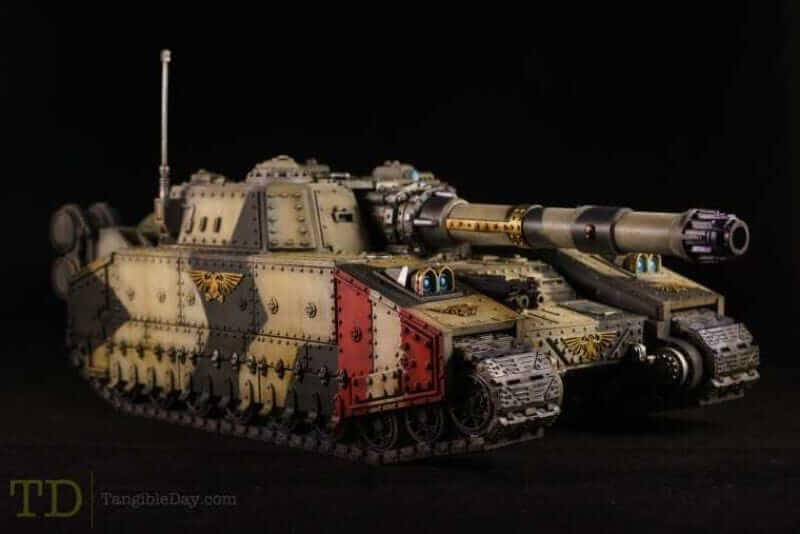
The light box also folds down into a compact “suitcase” and has pockets to carry the accessories, e.g., lights, tabletop tripod. This light box is the best balance between portability and size.
Finally, if you’re looking to stick to a budget and mostly photographing light vehicles or smaller models, this light box is the best value.
4. Neewer LED Shooting Tent

The Neewer LED Shooting Tent is similar in size to the LimoStudio (#3 above).
But, it has several advantages, which you may want to consider. First, it comes with a more power LED lighting system that is embedded within the light box itself.
The LEDs are also dimmable, so you can adjust how much light you want on your model. This can be helpful if you’re looking to reduce reflections on specific surfaces. Or, if you’re looking to image other things like dioramas or toys.
I can see eBay sellers using this to photograph products.
The other feature that is worth noting is the ability to shoot photos from different angles. You can take photos from a bird’s eye view, or the standard straight-on perspective. I could definitely see this as handy.

Check out the other features here.
The Neewer light box also comes with several colored backdrops, including black, white, and an emerging favorite, neutral gray.
The photo box folds into itself as a storage bag where you can store the power adapter and other accessories. None of the light boxes here require tools to setup or disassemble.
5. Samtian Photo Box
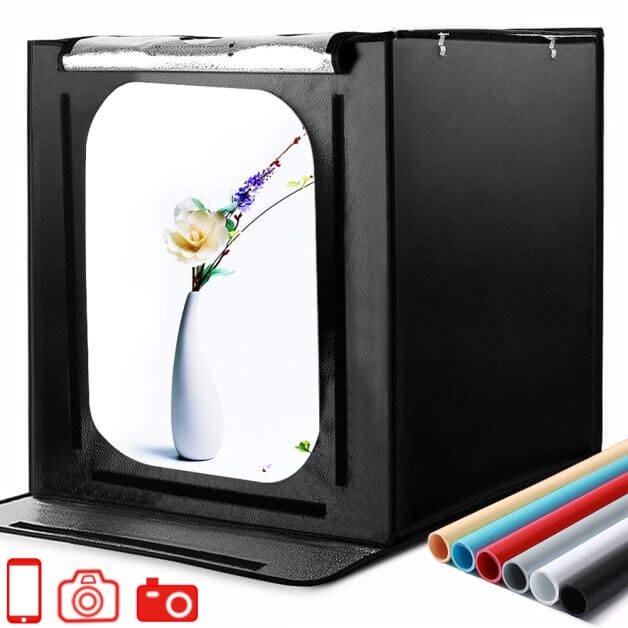
The Samtian Photo Box is the largest light box I’d recommend for photographing miniatures. If you’re photographing anything that requires a larger light box, then I’d argue you’re not photographing “miniatures”.
With an interior shooting space of 24″ x 24″ x 24″ (60 x 60 x 60cm), you can easily photograph some of the 40k Titans from Forgeworld. For example, a Warlord Titan stands about 22″ (56cm) tall and will fit inside this light booth.
As with the other light boxes, the Samtian photo box comes with super powerful LEDs (embedded inside the booth; 126 LEDs at 4200 lumens). If these are too bright, the system also has a dimmer so you can adjust brightness. Awesome.
The lighting is neutral colored which is great for creating images with accurate color representation.
Like the Neewer light box, this light booth also allows you to photograph your miniatures or other subjects at different angles.
Instead of having to prop your vehicles in the vertical direction to get a top-view photo, you can just take your camera and photograph from the roof of the photo light box.
The Samtian light box also comes with multiple colored backdrops that fit perfectly in the space inside the booth. Although I’ve mentioned black and white as the most versatile colors, I’d suggest experimenting to see what you prefer.
Overall, this is the best light box for those of you looking for something larger to photograph the bigger “miniatures” and models. You may even find this useful and fun for photographing other things around your home.
What More Photo Backdrops?
Here is a place for getting additional backdrops. You can check out reviews for the Tablewar backdrops here.
If you’re looking to print-out your own backdrops, grab my free download & print photo backdrops in the shop.

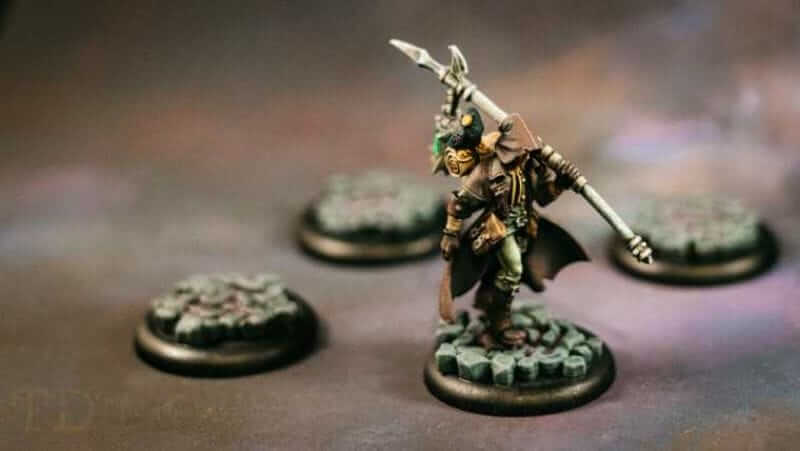
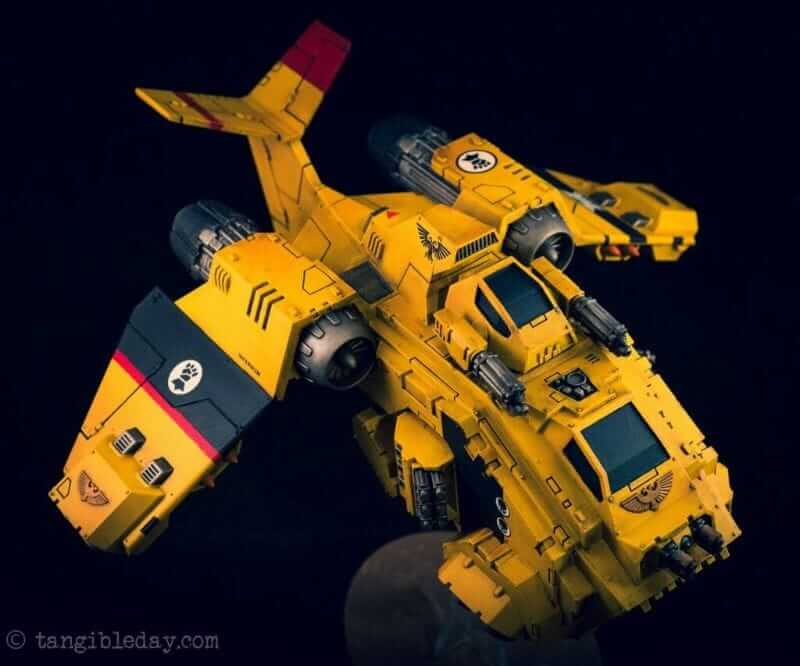
Summary
Check out my gallery or Flickr page where you’ll see miniatures I photographed using my photo light box. I take most of my photographs with a light box, because everything is already setup. All I need to do is place the model, adjust the camera, and shoot. Because it’s already a controlled environment, I don’t have to waste time figuring out the logistics.
For photography, remember: context, composition, and light.
Deciding on Getting a Light Box? Check These Out!
- Most portable: Emart Photography Table Top Light Box
- Best value: Travor Photo Light Box Portable
- Most versatile: LimoStudio Table Top Photo Photography Studio
- Balanced features: Neewer LED Shooting Tent
- Largest: Samtian Photo Box
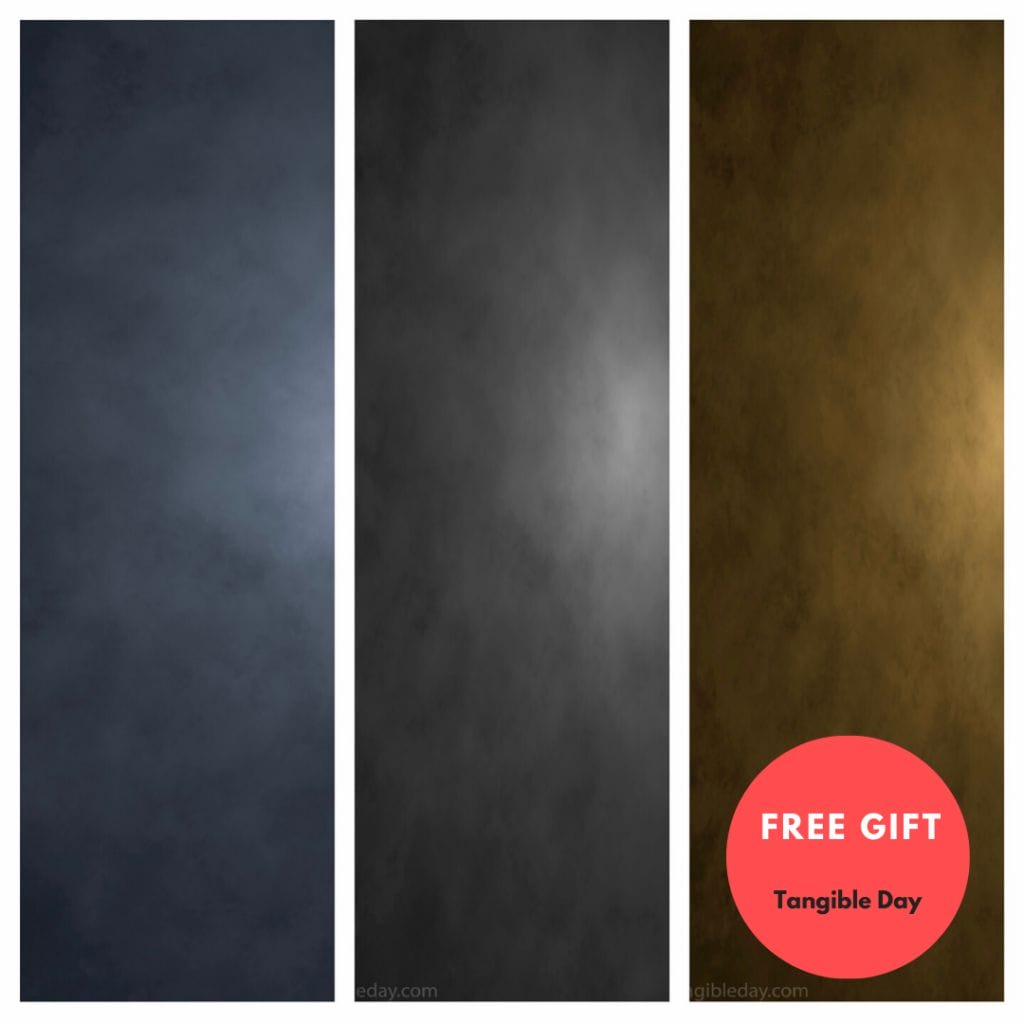
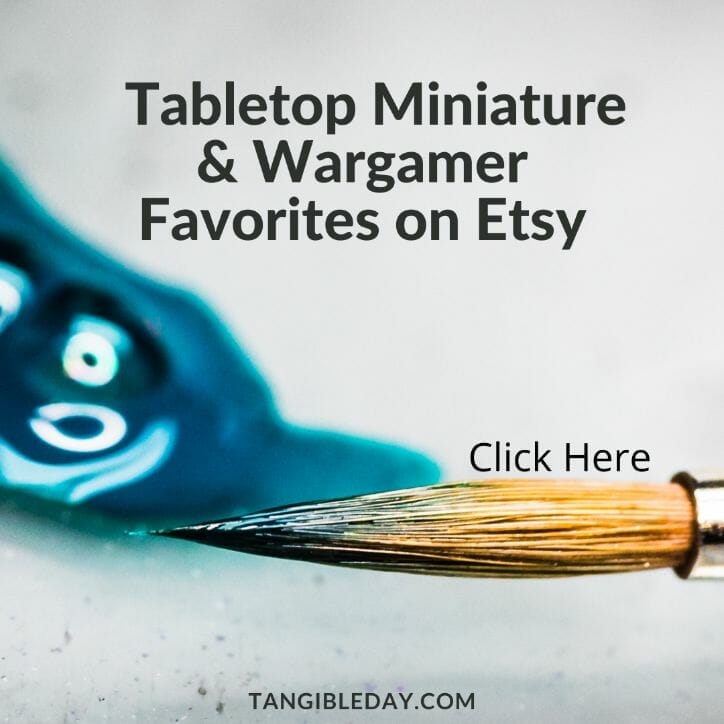
Tangible Day on YouTube (Miniatures and More!)
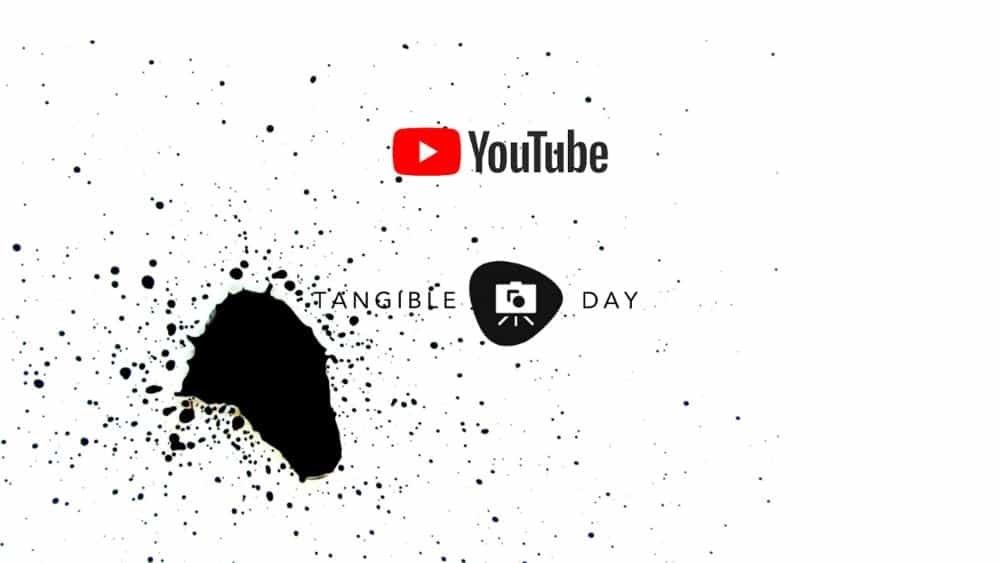
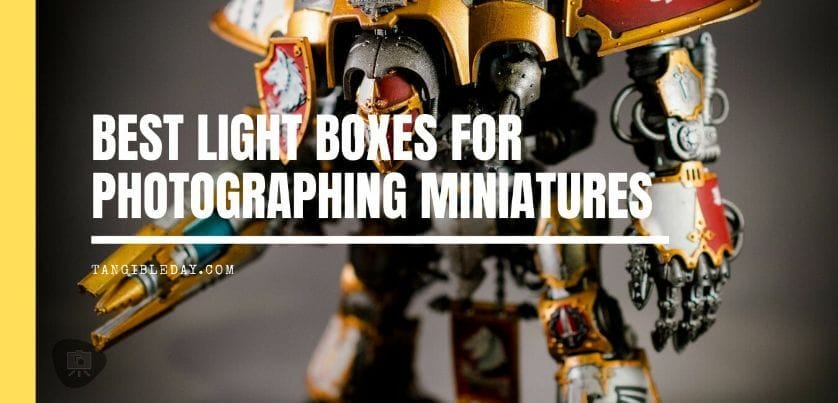
Been considering a lightbox. Are the boxes with built in lights really better than having separate lights shining from outside? I would have thought the built in lights would have diffusion issues.
Good question. The built-in lights are already diffused for a soft light. Those light boxes have diffusers engineered into them.
Thanks, that makes sense. The convience of having everything built in is swaying me in that direction.
Yeah I do recommend those if you don’t need them to move them around a lot.